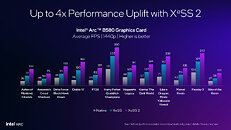
Intel Arc GPU Graphics Drivers 101.6913 WHQL Released
Intel today released the latest version of the Arc GPU Graphics Drivers. Version 101.6913 WHQL comes with optimization for "Mecha BREAK." The release also fixes a handful of issues. For Intel Arc B-series "Battlemage" discrete GPUs, a couple of issues are fixed. A bug that causes "Returnal" to experience an application crash during gameplay with ray tracing enabled, has been fixed. An intermittent application freeze with SPECapc for Maya 2024 during benchmark, has been fixed. The release also fixes a bug specific to the Arc "Battlemage" iGPUs of Core Ultra 200-series "Lunar Lake" processors, specifically, "Valorant" being unable to enumerate supported resolutions in game settings. Grab the drivers from the link below.
DOWNLOAD: Intel Arc GPU Graphics Drivers 101.6913 WHQL
DOWNLOAD: Intel Arc GPU Graphics Drivers 101.6913 WHQL









































































